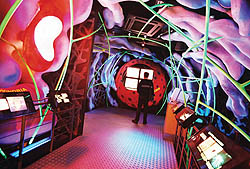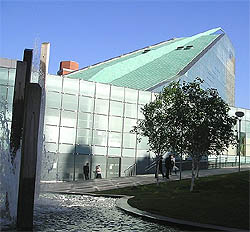Museums and libraries in Manchester
Museums
 At the Manchester Museum
At the Manchester Museum The Manchester Museum is part of the University of Manchester. Directly across Oxford Road from the main Congress venue, it is close enough to visit in between sessions. The Museum grew out of a combination of large-scale natural-historical collections in the nineteenth century, and housed the original teaching collections of the early University. Its collections focus on zoology (including a vivarium), botany, mineralogy, and Egyptology.
A complementary collection, focusing more on the physical sciences, engineering and communications, is to be found at the Museum of Science and Industry (MOSI), in the key industrial heritage district of Castlefield. The huge MOSI site is home to the new “Revolution Manchester” gallery, showcasing the city’s innovation heritage; artefacts from the history of textile production and international trade; the Power Hall, with its unrivalled collection of working engines; an Air and Space Gallery; and Underground Manchester, an evocative exploration of Victorian sewerage and sanitation. Most famously, the Museum incorporates the former Liverpool Road Station, the oldest extant passenger rail station in the world, whose story is told in an on-site exhibition.
The city’s other large museums also reflect its scientific, industrial and healthcare heritage. The People’s History Museum tells the history of the organised labour movement, reflecting the social dimensions of urban-industrial change. This museum’s fabric also has industrial roots: the main building was once a high-pressure pumping station, supplying hydraulic power ‘on tap’ to businesses across the city. The Imperial War Museum North, an impressive new building at Salford Quays, has a gallery devoted to science, technology and war.
Other sites in the city include the Greater Manchester Police Museum (limited opening) and Manchester Jewish Museum. The Pankhurst Centre addresses the women’s suffrage movement, in which Manchester played a major role; and the Gaskell House (84 Plymouth Grove) has displays on the life and family of Elizabeth Gaskell, author of the definitive industrial novels, Mary Barton and North and South.
The Gallery of Costume in Platt Fields Park grew out of local textile collections, and tells the story of clothing – from high fashion to workwear – across the generations. Across the river, but easily reached (take the train from Oxford Road), Salford Museum and Art Gallery has a range of exhibits including a detailed re-creation of a typical Victorian street. At Cheetham Hill, to the north, the Museum of Transport focuses on public transport vehicles, with a large collection of buses.
 The National Football Museum
The National Football MuseumFootball (soccer) is an equally inevitable contributor to the city’s celebration of its heritage. Manchester’s newest attraction, opened in summer 2012, is the National Football Museum, located in the distinctive modernist Urbis building. Both Old Trafford and the City of Manchester Stadium contain museum areas devoted to their respective clubs: though the Congress will take place outside the playing season, you can visit these areas as part of organised tours of the grounds.
Libraries
Manchester has an important role in library heritage. The first free public library in the modern sense (funded from public rates) may no longer be standing, but a much older contribution is still with us: Chetham’s Library, the oldest surviving public reference library in the English-speaking world, founded in 1653, and in the 1840s the haunt of Karl Marx and Friedrich Engels. The site, which is open to visitors by appointment, is home to priceless early book and manuscript holdings.
The John Rylands Library, Deansgate is the main Special Collections and Rare Books site for the University of Manchester, but stands on a separate site in the city centre, housed in a unique Victorian Gothic building which has recently been made fully accessible through an exterior addition. The Library has a display area featuring changing exhibitions, based on its own collections and material from elsewhere.
 The stunning interior of the Rylands Deansgate
The stunning interior of the Rylands Deansgate Another nineteenth-century presence is the Portico Library, which still operates today in its original function as a private subscription collection. The Portico is particularly famed for its association with John Dalton (who performed the ceremonial function of clock-keeper) and Peter Mark Roget, of Thesaurus fame.
The University of Manchester Library is the largest non-legal deposit library in the United Kingdom. Researchers hoping to combine their visit with research at the Library should contact the local organisers. The main library run by the city, the imposing circular Manchester Central Library, is currently undergoing renovation, but is expected to re-open with new facilities in 2013. The Working Class Movement Library, in Salford, is a reference collection on popular activism from the 1760s to the present.
See also our Local research resources page for specific advice on research possibilities for visitors.